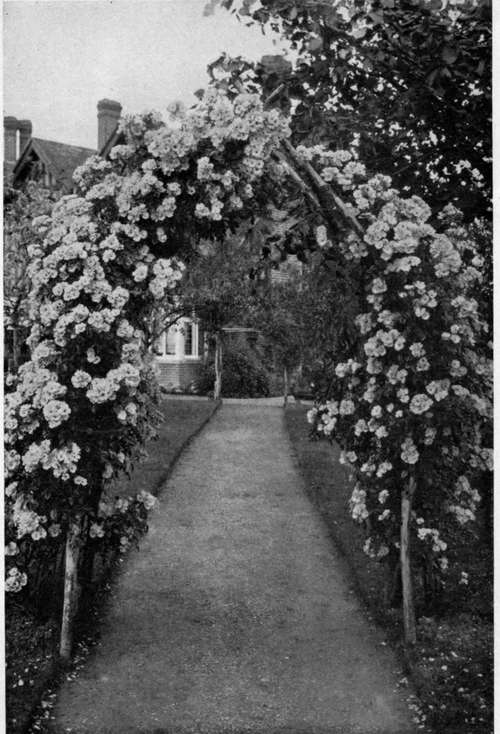Climbers For House Walls
Description
This section is from the book "What England Can Teach Us About Gardening", by Wilhelm Miller. Also available from Amazon: What England Can Teach Us About Gardening.
Climbers For House Walls
Meanwhile a man's first duty is toward his house walls, so let us consider them before we do the porch. And the first big fact is that climbers are so easy to grow and so long-lived that questions of fitness are of far greater importance than details of cultivation. England can teach us relatively little about new kinds of climbers or better ways of cultivating them, but we have everything to learn about artistic ways of using them. We are so ignorant that we often use wood-destroying climbers on wooden houses, and as to our public taste — well, we live in what might be called the "Crimson Rambler period." Before you go to England you dimly realize that we are in the experimental stage. But in England any one can see that most of the experiments we are trying have long ago been settled. In old countries there has grown up a consensus of opinion or public taste. And better still, certain principles have been evolved.
The first principle is that good architecture should never be obscured, and, conversely, bad architecture should be not only hidden but transmuted into beauty. Thus, on good architecture we should use climbers that are slender and decorative, not rampant or commonplace. Good ornamentation will be hidden by-Japan ivy. Nice proportion will be obscured by Virginia creeper. Hall's honeysuckle is too commonplace in leaf for walls of classic beauty. On the other hand, the leaf form of the grape is of undying charm. Every kind of clematis is light, airy, graceful. The Crimson Rambler is too gaudy, but the memorial rose is sufficiently slender and decorative.
Now let us take the case of bad architecture. Japan ivy will hide more ugliness than anything in the world — except charity for it will cover a brick tenement six stories high. But, please notice that Japan ivy and all other close-clinging climbers outline the object they cover and have no power to transmute ugly lines into beautiful masses, as the loose-hanging climbers do. A useless cupola or "fake" balcony may be mercifully softened by Virginia creeper but excrescences and bad lines are accentuated by English or Japanese ivy.
The next question is whether the house is of wood, brick, or stone. If it is of wood it is sheer folly to use the wood-destroying climbers. English and Japanese ivy and the climbing euonymus send out roots from the stem and these make the wood rot. Wistaria is the boa-constrictor among plants, weakening pillars and prying off shingles. So, too, does the trumpet creeper. All other climbers are safe, provided we do not let them grow directly on the wooden walls.
For when you wish to repaint your house you will find that the tendril-bearing and other self-fastening climbers are fragile. It is a big job to take them down, and you are sure to harm them, while the twiners are tough and can be taken down and replaced more easily.
If you have a brick or stone house you can grow any kind of climber directly on the walls, for there is no need of painting. But now the most important question becomes colour harmony. If you doubt this walk down any street in July and watch the Crimson Ramblers and purple clematis swearing at the red brick walls! The only safe thing to use against red brick are white flowers and green foliage. The warm colours in brick and stone are the reds and browns; the cool ones are the grays, blues, and yellows. Against light, delicate or neutral backgrounds you may use strongly coloured flowers, like red roses, orange trumpet creepers, purple and rose clematis and yellow ramblers. But the brick that is warm in winter looks too hot in summer and to cool it you can do one of two things. First swathe it with English ivy (plate 74), Japanese ivy (plate 76), euonymus, or Virginia creeper (plate 74). Second, you may decorate it with Clematis paniculata, white cluster roses, or white wistaria and the like.
The great practical difficulty with brick and stone is that the tendril-bearers cannot get up a smooth surface, while the twiners must always have support. Of course, chicken wire or wooden trellises can be used, but they have a trifling look against massive buildings. So far as I know, the architects have never solved the problem of growing slender, flowering climbers on smooth brick or stone. In such cases people generally use the self-climbing Japanese or English ivy, the euonymus or the selfclimbing variety of Virginia creeper. How little imagination we commonly employ is shown by the thousands of wistarias trained up iron rods in New York. They look to me like enchanted princesses with their arms frozen to their sides, until some good fairy comes to release them. After that they may entwine balconies, embellish window sills, and envelop the whole building with an atmosphere of poetry.

AX ARCH of BLUSH RAMBLER ROSES, ONE OF THE MANY INTERESTING WAYS OF TRAINING CLIMBERS, TO WHICH WE SHOULD GIVE MORE THOUGHT. See page 223.
Continue to:
- prev: Chapter XVIII. English Effects With Hardy Climbers
- Table of Contents
- next: The Best Ways To Train Vines
Tags
garden, flowers, plants, England, effects, foliage, gardening
